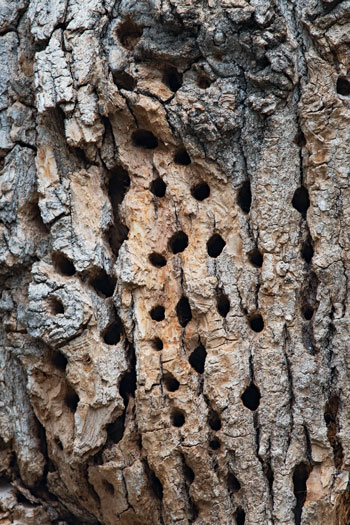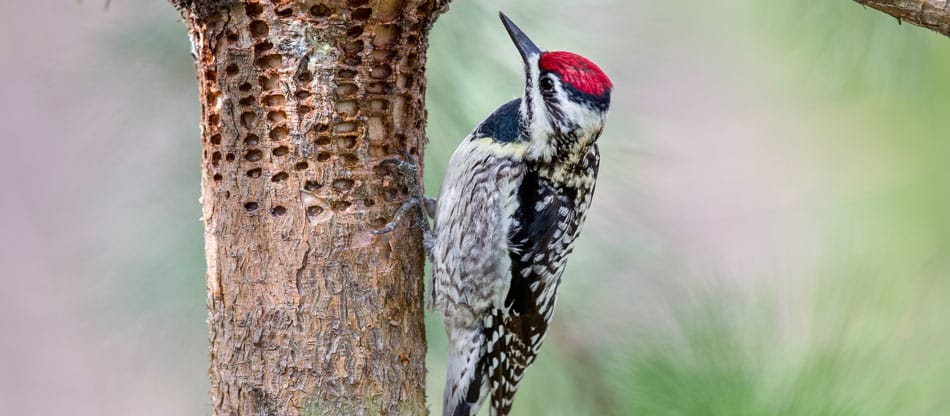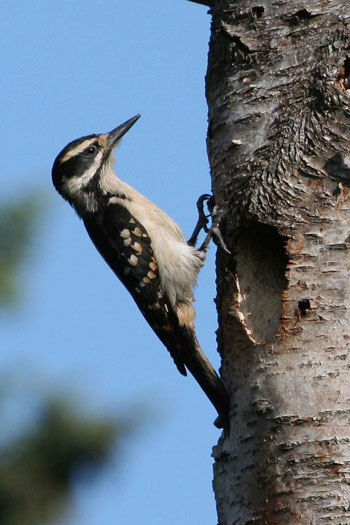Woodpeckers can be annoying, but if they’re pecking holes in your trees it usually points to a much bigger problem.
If you think that someone clicking a pen over and over is annoying, imagine that sound amplified and continuing non-stop. That’s what a woodpecker at work can sound like, and if you’re one of the few that have never heard or experienced it, consider yourself lucky. Woodpeckers will make their unique (and loud!) tapping sound from 8,000 to 12,000 times a DAY.
While woodpeckers are important to the ecosystem and are protected under federal and state laws (keep this in mind if you hear one knocking in the middle of the night), they can also cause damage to your trees, wood siding, or wooden window frames.
(Never heard a woodpecker before? Click here to hear one in action).
In our part of the country there are seven species of woodpecker that are commonly seen (listed from smallest, about 7 inches long, to largest, about a foot tall) –
- Downy woodpecker
- Yellow-bellied sapsucker
- Hairy woodpecker
- Red-bellied woodpecker
- Red-headed woodpecker
- Pileated woodpecker
- Northern flicker

Holes caused by woodpeckers looking for something to eat
Why do woodpeckers drill into trees?
The most common reason woodpeckers use their beaks to create holes in trees is that they are looking for food. Woodpeckers eat insect larvae that are found beneath the surface of tree bark. Some, like the yellow-bellied sapsucker, drill into trees to feed on sap, as well as any bugs caught in the tree sap.
In the spring, woodpeckers make even more noise as they use their drilling sounds to attract a mate and to establish their territory. In those instances, they choose objects for the resonant sounds that they make – you might hear one on a metal pole or on a metal gutter, for instance. Or they may peck at the same dead branch every year, or they might start tapping on your wood siding. This unique form of communication referred to as “drumming,” is used by both male and female woodpeckers and is often most noticeable (and annoying) during the early hours of the morning.
Also in the spring, woodpeckers will drill into dead or dying trees to create nests. While in most cases the bird creates small holes when feeding (either in a straight line or in no discernable pattern, depending on the species), for nesting the hole will be much larger.
How does a woodpecker know what trees to go to?
The most common types of trees to sustain woodpecker damage include pine trees, spruce, birch, fruit trees, and sweet gums.
Trees with softer wood are a woodpecker’s preferred dining place, but if any tree contains wood borers or bark lice insects, they’ll drill into it in search of a tasty meal.
Any tree that is dead or dying will have softer wood and is therefore preferred by woodpeckers for nesting.
Scientists are still not positive how exactly a woodpecker knows which trees are infested with the insects they prefer to eat. Some posit that woodpeckers can hear movement inside a tree. (Can you imagine having super-hearing that enables you to hear a tiny wormlike object move?). As woodpeckers are interested in the larval form of insects, they’ll look for whatever holes or crevices the bugs used to get into the tree in the first place. And finally, they’ll use their tapping skills to find the hollow parts of a tree, where the larvae are most likely entrenched.
Are there any benefits to woodpeckers?
As mentioned earlier, woodpeckers are an important part of the ecosystem. In forests, they help get rid of insect infestations in trees. For example, woodpeckers have been known to remove up to 85% of emerald ash borer (EAB) larvae from infested ash trees.
In urban and suburban areas, woodpeckers help to identify issues in trees. If there are sporadic holes caused by woodpeckers all over a trunk and branches, it’s likely that your tree is infested or dying. You may also see bark torn off a tree or scattered on the ground by woodpeckers.
Woodpecker holes by themselves do not kill trees. However, the holes do leave a tree more vulnerable to disease and pests.
What do woodpeckers eat?
Woodpeckers like the larvae of wood-boring insects, such as the emerald ash borer. They also will snack on ants, termites, beetles and their larvae, spiders, bird eggs, caterpillars, and more. If bugs are not to be found, they will eat small rodents, lizards, fruit, or nuts. Depending on the species, they may also survive on tree sap.

Yellow-bellied sapsuckers drill holes so they can feed on tree sap
What should I do if my tree has signs of woodpecker feeding?
If you’ve been awoken by the telltale rat-a-tat-tat of a woodpecker, determine where the damage is. Check tree trunks and branches, wood siding, fence rails, or anything else on your property that is made from wood.
If there’s damage on any of your trees, contact us to determine if your tree has a wood boring insect or another pest. If the holes are created in straight lines, it may be a sapsucker, which can feed on sap in healthy trees. However, it’s best to have your tree professionally inspected either way.
The damage caused by woodpeckers is not life-threatening to a tree, but if not properly treated and cared for, it can cause added expense and injury over time. Talk to us about tree health care services to help your tree recover from woodpecker holes.

Woodpecker nesting hole
How do I prevent woodpecker damage?
These fascinating (albeit annoying) birds work as insect detectors for your trees, letting you know that there is a deeper issue that needs to be dealt with. For example, the first noticeable sign of EAB infestation in ash trees is usually the holes caused by woodpeckers as they search for EAB larvae.
However, that doesn’t mean that you want a woodpecker continually chipping away at your trees. There are many products, sprays, nets, and noisemakers on the market today that promise to repel woodpeckers.
Fake owls and such rarely deter woodpeckers, as they quickly find out that they don’t move or aren’t a threat. Noise is a good deterrent if you are consistent with it (for example, banging pots together when you see them to scare them away). Some have hung strips of shiny Mylar tape and have seen success in keeping woodpeckers at bay.
Harming or killing a woodpecker is never an option, as woodpeckers are classified as “migratory, nongame birds” and are protected by the Federal Migratory Bird Treaty Act. While not found in our part of the country, the red-cockaded woodpecker (Picoides borealis) and the ivory-billed woodpecker (Campephilus principalis) are on the Endangered Species list. (Wikipedia)
For more information or to address woodpecker damage to a tree, contact us today for a thorough inspection.
GET THE LATEST NEWS
Subscribe to the Organic Plant Care Newsletter and get timely and helpful tips and updates monthly.
There's no spam - we promise!





